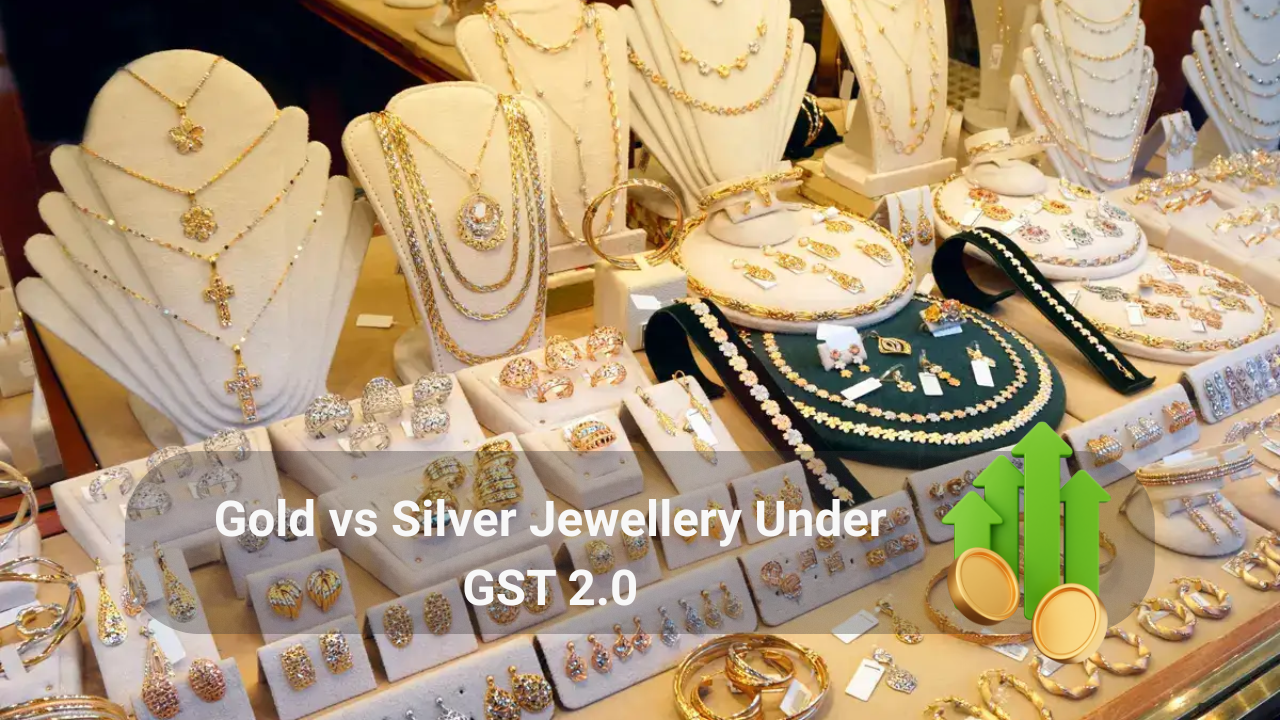Imagine you’re stepping into your favorite jewellery store, eyes gleaming at a beautiful gold chain or silver pendant. You’re excited but then you pause. What’s the real cost once GST is added? With the buzz around India’s recent GST 2.0 reforms (effective September 22, 2025), there’s been plenty of talk: Are jewellery prices going down? Will you finally get a break?
Here’s the scoop: despite sweeping changes to GST slabs simplified to 5%, 18%, and a steep 40% for luxury or sin goods the GST on gold and silver jewellery remains steady at 3% on the metal plus 5% on making charges. No surprise cuts here, but clarity and predictability are its own kind of gift.
What Changed Under GST 2.0 and What Didn’t
The Big Picture: GST Overhaul
- The GST Council replaced the old four-slab system (5%, 12%, 18%, 28%) with two core slabs 5% (essentials) and 18% (standard goods) plus a 40% slab for luxury and sin goods like cigarettes and premium cars.
- These reforms take effect from September 22, 2025, ahead of the festive shopping season.
What Stayed the Same for Gold & Silver
- The GST rate for gold and silver jewellery remains 3% on the metal value and 5% on making charges, unchanged by GST 2.0
- Similarly, gold and silver coins and bars attract 3% GST, with no making charge component.
- Experts affirm this consistency, noting indirect benefits to the jewellery market through increased consumer spending on essentials, not reduced taxes on ornaments.
GST 2.0 vs Jewellery GST: A Quick Comparison Table
| Item | Metal Value GST | Making Charges GST | Notes |
|---|---|---|---|
| Gold / Silver Jewellery | 3% | 5% | Unchanged under GST 2.0 |
| Gold / Silver Coins or Bars (Bullion) | 3% | — | No making charges involved |
| Gold ETFs / Sovereign Gold Bonds | — | — | GST-exempt on purchase |
| GST 2.0 General Slabs (Non-bullion) | 5% / 18% / 40% | Depends on product | Jewellery largely unaffected |
Breaking It Down with Examples
Let’s walk through real-world-style scenarios:
1. Buying Gold Jewellery
- Gold value (say): ₹1,00,000
- Making charges (e.g., 10%): ₹10,000
- GST on metal (3%): ₹3,000
- GST on making charges (5%): ₹500
- Total GST: ₹3,500 → Total cost: ₹1,13,500
A Marathi news source explains for jewellery worth ₹1 lakh, you’d pay around ₹3,000 GST on the metal and ₹500 on making so roughly ₹3,500 extra.
2. Buying Silver Idols or Utensils
- Silver value: ₹50,000
- Making charges: ₹5,000
- GST on silver (3%): ₹1,500
- GST on making (5%): ₹250
- Total GST: ₹1,750 → Total payment: ₹56,750
3. Exchanging Old Jewellery for New
- Old value surrendered: ₹80,000
- New jewellery cost (metal): ₹1,10,000
- Making charges: ₹10,000
- Taxable value addition: ₹30,000
- GST on addition (3%): ₹900
- GST on making (5%): ₹500
- Total GST: ₹1,400
This ensures you’re taxed only on the value added, avoiding double GST.
4. Buying Bullion Coins or Bars
- Value: ₹2,00,000
- GST (3%): ₹6,000
- No making charges apply.
Why This Approach Makes Sense
- Stability During Festivals
Consumers get clarity on GST costs for ornaments no last-minute surprises. - Boosting Discretionary Spending
Lower taxes on essentials (like food, electronics, vehicles) could free up cash, nudging consumers toward jewellery purchases indirectly. - Protecting Industry Predictability
Jewelers and exporters appreciate the tax consistency, even amid a broader reform wave The Times of India.
Reliable External Resources
- More on the two-tier GST structure and 40% luxury-goods slab: [Financial Times coverage of GST reforms]
- Deep dive into how jewellery GST calculations work: [BasuNivesh breakdown with practical examples]
- Industry sentiment on the unchanged GST rates for jewellery: [Economic Times commentary]
FAQs
1. Did GST 2.0 reduce GST on gold jewellery?
Nope gold and silver jewellery still attract 3% on metal plus 5% on making charges, even after GST 2.0.
2. When did these rates become effective?
While GST 2.0 which introduced the new slabs comes into force from September 22, 2025, the GST for jewellery remained unchanged at the 56th Council meeting on September 3, 2025.
3. Are gold investment instruments like ETFs or Sovereign Gold Bonds GST-free?
Yes! Those are GST-exempt on purchase, making them tax-efficient for investors BasuNiveshClearTax.
4. Do silver utensils get the same GST treatment as jewellery?
They do 3% GST on silver value and 5% on making charges, just like jewellery.
5. Why not just flatten the jewellery GST to something simpler, like a 4% flat rate?
Many hoped that would happen, but the Council preferred continuity for bullion taxation to preserve market stability amid sweeping GST changes.
Conclusion
So here’s the bottom line: even though India’s GST 2.0 marks a historic simplification of the tax regime, your GST on gold and silver jewellery remains the same 3% on the metal and 5% on making charges. What you gain instead is predictability in pricing, especially helpful during festive splurges.
While jewellery buyers might wish for lower tax rates, the indirect benefit is that reduced GST on essentials may leave more money in your pocket perhaps nudging you toward that piece you’ve been eyeing. And for investors, GST-free instruments like SGBs and ETFs offer a smart, low-tax way to build wealth. Smart, simple, and clear just how a chat with a friend should be.
Nand Kishor is a content writer covering business, economy, and world affairs. With a background in journalism, he focuses on clear, ethical, and insightful reporting. Outside of work, he enjoys chess, cricket, and writing short stories.
